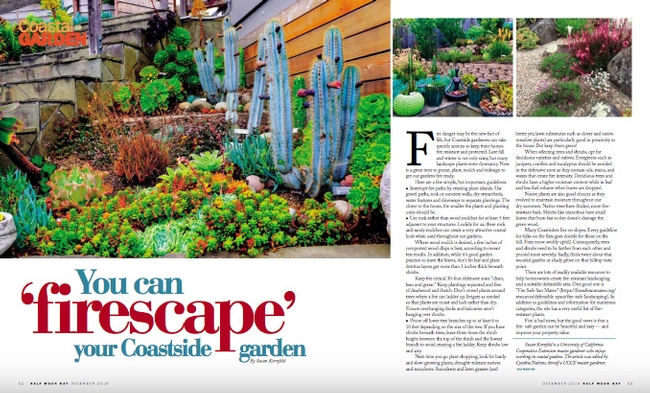Fire danger may be the new fact of life, but coast side gardeners can take specific actions to keep their homes fire resistant and protected. Late fall and winter is not only rainy, but many landscape plants enter dormancy; therefore, now is a great time to prune, plant, mulch, and redesign to get our gardens fire ready.
Here are a few simple, but important, guidelines:
-
Interrupt fire paths by creating plant islands. Use gravel paths, rock or concrete walls, dry streambeds, water features, and driveways to separate plantings. The closer to the house, the smaller the plants and planting units should be.
-
Use rock rather than wood mulches for at least five feet adjacent to your structures. Luckily for us, these rock and sandy mulches can create a very attractive coastal look when used throughout our gardens.
-
Where wood mulch is desired, a few inches of composted wood chips are best according to recent test results. In addition, while it's good garden practice to leave the leaves, don't let leaf and plant detritus layers get more than three inches thick beneath shrubs.
-
Keep the critical 30-foot defensive zone "clean, lean, and green." Keep plantings separated and free of deadwood and thatch. Don't crowd plants around trees where a fire can ladder up. Irrigate as needed so that plants are moist and lush rather than dry. Ensure overhanging decks and balconies aren't hanging over shrubs.
-
Prune off lower tree branches up to at least six to ten feet depending on the size of the tree. If you have shrubs beneath trees, leave three times the shrub height between the top of the shrub and the lowest branch to avoid creating a fire ladder. Keep shrubs low and airy.
-
Next time you go plant shopping, look for hardy and slow-growing plants, drought-tolerant natives, and succulents. Succulents and lawn grasses (and better yet, lawn substitutes such as clover and native meadow plants) are particularly good in proximity to the house. But keep them green!
When selecting trees and shrubs, opt for deciduous varieties and natives. Evergreens such as junipers, conifers, and eucalyptus should be avoided in the defensive zone as they contain oils, resins, and waxes that create fire intensity. Deciduous trees and shrubs have a higher moisture content while in leaf and less fuel volume when leaves are dropped.
Native plants are also good choices as they evolved to maintain moisture throughout our dry summers. Native trees have thicker, more fire-resistant bark. Shrubs like Ceanothus have small leaves that burn fast so fire doesn't damage the green wood.
Many Coastsiders live on slopes. Every guideline for folks on the flats goes double for those on the hill. Fires move swiftly uphill. Consequently, trees and shrubs need to be farther from each other and pruned more severely. Sadly, think
twice about that wooded gazebo or shady grove on that hilltop vista point.
There are lots of ready available resources to help homeowners create fire-resistant landscaping and a suitable defensible area. One good one is "Fire Safe San Mateo". In addition to guidelines and information for numerous categories, the site has a very useful list of fire resistant plants.
Fire is bad news, but the good news is that a fire safe garden can be beautiful and easy – and improve your property value.
Susan Kornfeld is a UCCE Master Gardeners who enjoys working in coastal gardens. The article was edited by Cynthia Nations, UCCE Master Gardener.
Attached Images:
